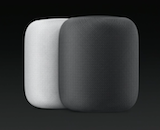
HomePod is designed to coordinate with Apple Music. It ties in to the owner’s specific library of playlists and preferences. It works with Siri to offer what the Apple exec dubbed a “musicologist”, and the voice controls are meant to accomplish both direct and indirect commands around what you might want to hear and what you’d want to know about your music. HomePod can respond with information about the liner notes or play a particular track or artist from the Apple Music catalog.
On the technology side, the debut of HomePod focused on audio quality, highlighting the device’s ability to manage the listening experience in different rooms and settings. One device can fill a living room, or two can work together for even more power. It also links up with other information such as news or sports, set reminders, or send Messages. It also works in conjunction with HomeKit devices for management of other smart technology.
Although this WiFi speaker segment is still a very new addition to the tech space, it has been seeing a strong uptake so far. The latest Infinite Dial data and an even more recent survey by audioBoom and Edison showed that they are already on listeners’ radar. About 20 million Americans currently own a device in this niche.
Apple Music is also getting spruced up on the Apple Watch. The new developments are designed to sync the wearable with the Apple Airpods, the wireless headphones-meet-earbuds that caused a big stir at the company’s keynote event in September. The Watch version now has automatically updated playlists and supports multiple playlists.

